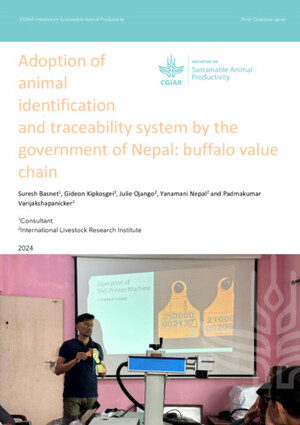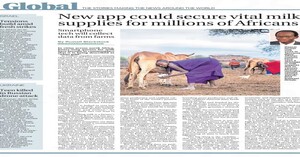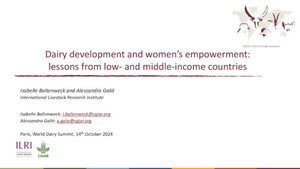
Dairy development in Kenya: the past, the present and the future
Abstract
Large increases in demand for milk and dairy products in developing countries are projected for the next 25 years. These represent exciting market opportunities for smallholders, such as those in Kenya, which has over 85% of the dairy cattle population in eastern Africa. Currently Kenya’s per capita availability of milk is four to seven times higher than the other countries in the region. The widespread adoption of dairy cattle by smallholders in Kenya was stimulated by several interacting factors: smallholder communities who kept cattle and who had milk as an important part of their diet; a sub-tropical geography suitable for dairy cattle; the presence of significant dairy populations (owned by settler farmers); and the conducive policy and institutional environments provided by successive Governments.
Today most of Kenya’s 3 million dairy cattle are kept by smallholders in crop-livestock systems in areas of high and medium cropping potential. Generally 1-2 dairy cows (mostly Holstein Friesian or Ayrshire) comprise 50% of the herd, the other half consisting of female calves and heifers. In the high potential areas feeding is mainly cut-and-carry with planted Napier grass (Pennisetum purpureum) and crop residues, especially from maize and bananas, supplemented by forages gathered from common properties around the farm or purchased from neighbours. On average total daily milk output is 10 kg per farm, of which a quarter is for home consumption and the rest sold. In the late 1980s, milk sales were mainly through local dairy co-operative societies, with some to neighbours. However, following market liberalisation in 1992, marketing channels have diversified. It is estimated that approximately 85-90% of marketed milk is not processed or packaged, but instead is bought by the consumer in raw form. The factors driving the continued importance of the informal market are traditional preferences for fresh raw milk (which is boiled before consumption), and consumers’ unwillingness to pay the costs of processing and packaging. Raw milk markets offer both higher prices to producers and lower prices to consumers. These markets also provide valuable opportunities for rural and urban employment.
In Kenya, therefore, as elsewhere in the tropics, market-oriented smallholder dairy farms are concentrated close to urban consumption centres because the effects of the market over-ride many production factors. Less proximate production occurs only in those regions where there is an efficient market infrastructure. As infrastructure develops, markets become more efficient and urban consumers develop stronger preferences for pasteurised milk, the advantages of proximity will be reduced and production may well move away from intensive peri-urban systems and shift to more extensive systems (as the New Zealand dairy industry illustrates on a global scale).
Until these infra-structural improvements occur, and because of the ready availability of cheap human capital (labour) and the relative expense of financial capital, smallholder dairy production and informal raw milk marketing are likely to predominate for the foreseeable future. Consequently it is anticipated in the medium term (10-15 years) that the industrialised model of dairy production, processing and marketing will remain a minor contributor to the dairy sub-sector in Kenya and elsewhere in the region.
Citation
Thorpe, W.; Muriuki, H.G.; Omore, A.; Owango, M.O.; Staal, S. 2000. Dairy development in Kenya: the past, the present and the future. Paper presented at the Annual Symposium of the Animal Production Society of Kenya (APSK). Theme: Challenges to Animal Production in this Millennium, KARI Headquarters, Nairobi, March 22-23, 2000. Nairobi (Kenya): ILRI










